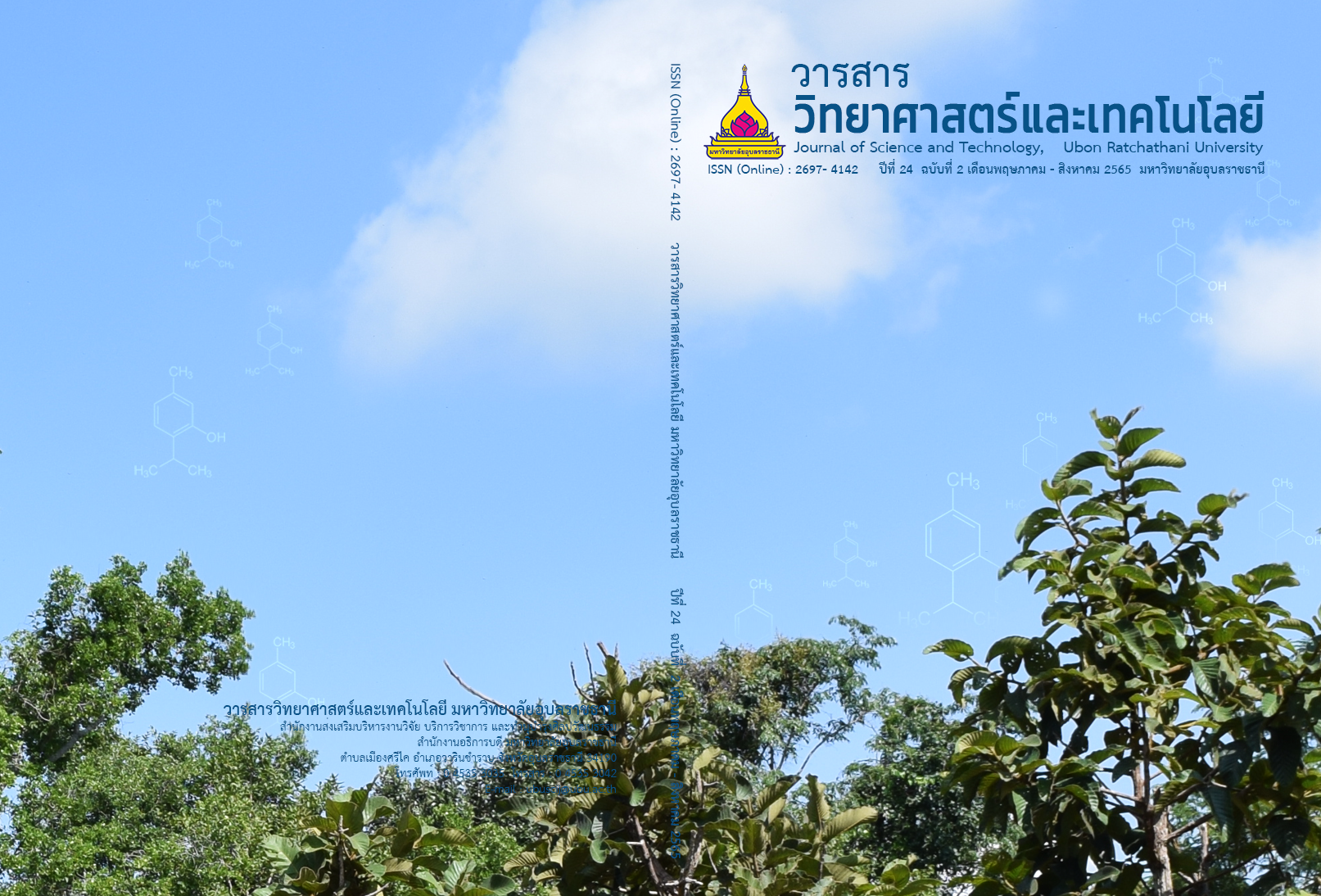ผลของความเข้มข้นของไกลโฟเสต พาราควอต และไซเปอร์เมทรินต่อการตายของ กุ้งก้ามแดง Cherax quadricarinatus (von Martens, 1868)
Main Article Content
บทคัดย่อ
งานวิจัยนี้มุ่งเน้นที่จะศึกษาผลของสารเคมี 3 ชนิด ได้แก่ พาราควอต ไกลโฟเสต และไซเปอร์เมทริน ต่อการตายเฉียบพลันของกุ้งก้ามแดง Cherax quadricarinatus (von Martens, 1868) ที่ห้องปฏิบัติการ คณะเกษตรศาสตร์ มหาวิทยาลัยราชภัฏอุบลราชธานี เพื่อประเมินความเป็นไปได้ในการควบคุมการรุกรานของกุ้งก้ามแดง ในกรณีที่กุ้งก้ามแดงหลุดรอดไปยังแหล่งน้ำธรรมชาติที่มีการปนเปื้อนของสารเคมีดังกล่าวทั้งสามชนิด ในการศึกษาได้สุ่มลูกกุ้งก้ามแดงระยะลงเดิน ความยาวเฉลี่ย 22.5±0.06 เซนติเมตร และขนาดน้ำหนักเฉลี่ย 0.85±0.03 กรัมต่อตัว ใส่บ่อพลาสติกขนาดความจุน้ำ 5 ลิตร บ่อละ 10 ตัว เก็บข้อมูลจำนวนตัวที่ตายทุก 24, 48 และ 72 ชั่วโมง ในแต่ละระดับความเข้มข้นของสารเคมีที่ใช้ พบว่าอัตราการตายของลูกกุ้งก้ามแดงเพิ่มขึ้นเมื่อระดับความเข้มข้นของสารเคมีทั้ง 3 ชนิดเพิ่มขึ้นในทุกช่วงเวลาที่ทำการศึกษา โดยความเข้มข้นที่ทำให้ลูกกุ้งก้ามแดงตายร้อยละ 50 ของไกลโฟเสตที่ชั่วโมงที่ 24, 48 และ 72 เท่ากับ 8.518, 7.161 และ 6.252 ส่วนในล้านส่วน ตามลำดับ ในขณะที่ความเข้มข้นที่ทำให้ลูกกุ้งก้ามแดงตายร้อยละ 50 ของพาราควอต ที่ชั่วโมงที่ 24, 48 และ 72 เท่ากับ 0.719, 0.482 และ 0.363 ส่วนในล้านส่วน ตามลำดับ ส่วนความเข้มข้นที่ทำให้ลูกกุ้งก้ามแดงตายร้อยละ 50 ของไซเปอร์เมทริน ที่ชั่วโมงที่ 24, 48 และ 72 เท่ากับ 0.007, 0.005 และ 0.003 ส่วนในล้านส่วน ตามลำดับ ผลการทดลองนี้แสดงให้เห็นว่าไซเปอร์เมทรินมีผลต่ออัตราการตายเฉียบพลันต่อลูกกุ้งก้ามแดงมากที่สุด รองลงมาคือพาราควอต และไกลโฟเสต ตามลำดับ ด้วยเหตุที่ค่าความเข้มข้นสูงสุดของสารเคมีที่ยอมรับได้ในสิ่งแวดล้อมมีค่าต่ำกว่าค่าความเข้มข้นที่ส่งผลต่อการตายเฉียบพลันของลูกกุ้งก้ามแดงที่ได้จากการทดลองนี้ ดังนั้นจึงมีความเป็นไปได้น้อยที่ความเป็นพิษที่ปนเปื้อนอยู่ในแหล่งน้ำธรรมชาติจะสามารถควบคุมการรุกรานลูกกุ้งก้ามแดงในกรณีที่หลุดรอดไปในสิ่งแวดล้อมดังกล่าว
Article Details

อนุญาตภายใต้เงื่อนไข Creative Commons Attribution-NonCommercial-NoDerivatives 4.0 International License.
บทความที่ได้รับการตีพิมพ์เป็นลิขสิทธิ์ของ วารสารวิทยาศาสตร์และเทคโนโลยี มหาวิทยาลัยอุบลราชธานี
ข้อความที่ปรากฏในบทความแต่ละเรื่องในวารสารวิชาการเล่มนี้เป็นความคิดเห็นส่วนตัวของผู้เขียนแต่ละท่านไม่เกี่ยวข้องกับมหาวิทยาลัยอุบลราชธานี และคณาจารย์ท่านอื่นๆในมหาวิทยาลัยฯ แต่อย่างใด ความรับผิดชอบองค์ประกอบทั้งหมดของบทความแต่ละเรื่องเป็นของผู้เขียนแต่ละท่าน หากมีความผิดพลาดใดๆ ผู้เขียนแต่ละท่านจะรับผิดชอบบทความของตนเองแต่ผู้เดียว
เอกสารอ้างอิง
National Bureau of Agricultural Commodity and Food Standards Ministry of Agriculture and Cooperatives. 2008. Pesticide Residues: Maximum Residue Limits. https://www.acfs.go.th/standard /download/eng/MRL.pdf. Accessed 15 May 2021.
Capinha C. and et al. 2015. The dispersal of alien species redefines biogeography in the Anthropocene. Science. 348(6240): 1248-1251.
Srisaart, A. and Thinkaownoi, S. 2015. Examples and Methods of Raising Red Lobsters. Naka intermedia, Bangkok. 22 (in Thai)
Srisaart, A. 2015. Solution Red Lobster Farming. Bangkok: Naka intermedia. 124. (in Thai)
Petchoi, C. 2017. Application of agrochemicals in the lower Mekong basin. Journal of Science and technology Ubon Ratchathani University. 19(1): 111-122. (in Thai)
Peruzzo, P.J., Porta, A.A. and Ronco, A.E. 2008. Levels of glyphosate in surface waters, sediments and soils associated with direct soybean cultivation in north pampasic region of Argentina. Environmental Pollution. 156(1): 61-66.
Wilson, C. and Tisdell, C. 2001. Why farmers continue to use pesticides despite environmental, health and sustainability costs. Ecological Economics. 39(3): 449-462.
Rao, P.S.C. and Davidson, J.M.. 1980. Estimation of Pesticide Retention and Transformation Parameters Required in Nonpoint Source Pollution Models. Ann Arbor, MI: Ann Arbor Science Publishers.
Leadprathom, N. and Hiransajjaled, R. 2005. Project on the Effects of Herbicides on Proteins Involved in Osmoregulation in Young Seabass (Lates calcarifer). http://dspace. lib.buu.ac.th/xmlui/handle/1234567890/1474?show=full. Accessed 1 April 2021. (in Thai)
Leadprathom, N. and et al. 2004. Effects of salinity on acute toxicity of cypermethrin and paraquat in sea bass. Journal of Fisheries Technology Research. 7(2): 82-93. (in Thai)
Sangchan, W. and et al. 2014. Monitoring and risk assessment of pesticides in a tropical river of an agricultural watershed in northern Thailand. Environmental Monitoring and Assessment. 186(2): 1083–1099.
Soares, M.P. and et al. 2019. Cypermetrin-base formulation Barrage induces histological change in gill of the Pantanal endemic shrimp Macrobrachium pantanalense. Environmental Toxicology and Pharamacology. 67: 66-78.
Wang, X. and et al. 2013. Low salinity decreases the tolerance to two pesticides, beta-cypermethrin and acephate, of white-leg shrimp, Litopenaeus vannamei. Journal of Aquaculture Research and Development. 4(5): 1000190.
Aungsunnern, S. 2015. Environmental Impact from Pesticide Utilization. EAU Heritage Journal Science and Technology. 9(1): 50-63. (in Thai)
Leadprathom, N. 2013. Toxicity of paraquat to aquatic animal. King Mongkut's Agricultural Journal. 31(2): 95-101. (in Thai)
Thanomsit, C. and Malaram, N. 2017. Effects of glyphosate on aquatic life. Kochchasarn Journal of Science. 39(1): 98-109. (in Thai)
Banaee, M. and et al. 2019. Acute exposure to chlorpyrifos and glyphosate and glyphosate induces changes in hemolymph biochemical parameters in the crayfish, Astacus leptodactylus (Eschscholtz, 1823). Comparative Biochemistry and Physiology Part C: Toxicology & Pharmacology. 222: 145-155.
Environmental Protection Agency. 2008. Reregistration Eligibility Decision for Cypermethrin. https://nepis.epa.gov/Exe/ZyPDF. cgi/P100BE6X.PDF? Dockey=P100BE6X.PDF. Accessed 30 May 2021.


